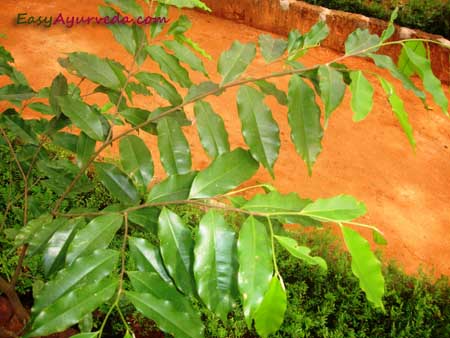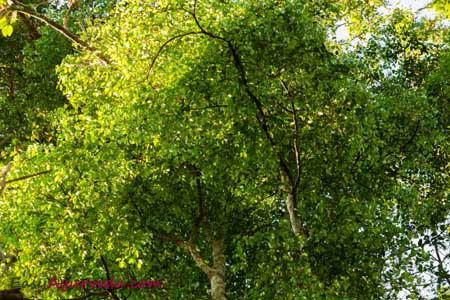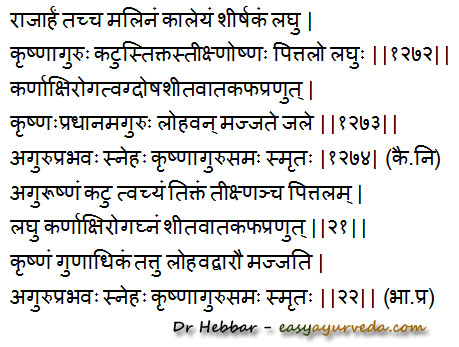Agaru (Agarwood) Aquilaria agallocha Uses, Research, Side Effects
Agaru, Aquilaria agallocha is a fragrant tree, commonly known as Agarwood, Aloeswood, Eaglewood etc. It is used in treating diseases related to ear, nose, throat, asthma, cough etc.
Botanical Name-Aquilaria agallocha Roxb.
Family- THYMELAEACEAE (Agaru kula)

Table of Contents
Vernacular names
Names in different languages:
English Name – Agarwood, Agilawood,
Hindi Name- Agar
Bengali Name- Agaru
Telugu Name- Agaru
Tamil Name- Aggalichandanam, Agalichandanam
Gujarati Name-Agar
Bengali name- Agaru
Malayalam name – Akil
Sanskrit synonyms
Krumija, Krimijagdha, Anaryaka, Vishvaroopakam, Pravara, Jongakam, Shreshta Vruksha, Rajarha, Vamshika, Yogajam, Dhoopavasam,
Loha – It is heavy and black, similar to Iron.
Anaryaka – Plant grows commonly in the hilly regions of North Eastern part of India
krimija – Originated from fungus infestation
Yogajam – The aromatic heartwood is formed by infestation
Dhoopavasam – Aromatic heartwood is used in Perfumery
Pravaram – Agaru is a potent herb
Classical categorisation
Charaka –
Sheeta Prashamana – Group of herbs to relieve feelings of coldness, moistness.
Shvasahara – Group of herbs that relieves asthma, bronchitis
Shiro Virechanopaga – Group of herbs useful in Nasya treatment
Tikta skandha – Bitter tasting group of herbs.

Sushruta- Salasaradi, Eladi,
Sleshmashamana – Kapha balancing group of herbs.
Vagbhata- Salasaradi, Eladi
Bhavaprakasa – Karpooradi varga
Properties
Physical properties of Agarwood:
The bark of agaru exhibits a pleasant aroma and thus finds a place in the groups of medicines used for fumigation type of treatment used in conditions of non healing skin ulcers exuding discharges to desiccate the surface of the ulcers.
Varieties
In Dhanvantari Nighantu another variety Kaleyaka is mentioned.
Sodhala Nighantu explains about three types – Agaru, Krishna Agaru and Kakatunda Agaru.
Rajanighantu quoted four varieties viz.
Krishna agaru (black)
Kashta agaru (yellow)
Dahagaru and
Mangalyagaru.
The agaru is of two varieties based on the color of the bark –
1] Whitish [shveta aguru] and
2] Blackish [Krishna Agaru] – This is considered superior.
Categories:
[Wealth of India Vol-1]. Depending on the extent of resin accumulation, heart wood is graded into 4 categories.
1. Grade I/Black/True Agar
2. Grade II/Bantang
3. Grade III/Bhuta/Phuta
4. Grade IV Dhum
Formation
Agar is the pathological product of a fungal disease contracted by the tree chiefly through wounds on the trunk.
The fungus infested trees furnish the agarwood which occurs as dark coloured resinous fra grant masses in the of the bole.
The wood infected by certain fungi, develops large and irregular patches of dark streaks charged with an oleoresin and becomes odoriferous. The intensity of the dark patch or agar is a measure of the quantity of oleoresin present.
Agar is frequently found in trees that are 20 yrs old; but commercially exploitable amounts of agar are found in 50 yr old trees. Trees 80 yrs old are known to be the richest in their content of agar wood.
Distribution
Found in the eastern parts of India in July- august. Arunachal Pradesh, Assam, Maipur, Nagaland, Tripura.
It is also found in Bhutan, Myanmar, Sumatra and Malaysia.
Major chemical constituents
Agarospirol, Aquillochin, Holocellulose, Lignan, Pentosans, Essential ois viz. Agarol (a sesquiterpene alcohol, the main odoriferous component) a-and b- Agarofurans; nor- keto- agarofurans, Jinkohol, Jinkoheremol,Dihydrokaranone, Kusunol, agarotetrol etc.
(Reference: Illustrated Dravyaguna Vijnana, Vol. II, by Dr JLN Shastry)
Therapeutic properties
Aquilaria agallocha therapeutic Properties-
Rasa (taste) – Katu (pungent), Tikta (bitter)
Guna (qualities) – Laghu (lightness), Teekshna (strong, piercing)
Vipaka- Katu – Undergoes pungent taste conversion after digestion.
Veerya- Ushna – hot potency
Effect on Tridosha: Balances Kapha and Vata Dosha
Action: Tvachya, Karnarogahara, Akshirogahara, Sitapanayana, Kushtaghna
Part used, dose
Part Used – Aromatic resinous wood, oil – called Agarwood oil, Aloeswood oil.
Dose – powder 3-5 grams in divided dose per day. Oil – 1 – 5 drops.
Medicinal uses
Aquilaria agallocha medicinal uses
(Charaka Sutrasthana 25th chapter)– Application of Rasna (Pluchea lanceolata) and Agaru (Aquilaria agallocha) is best in removing coldness, on external application.
Kasa (Cough)
In Kasa (Cough) Agaru churna should be taken with Madhu (Honey) (AH Chi)
Lavanameha
Susrutacharya recommends the kwatha (Decoction) prepared from patha and Agaru in Lavana meha.
Dushta Vranashodhana – Cleanses wounds
Kushtahara – useful in skin diseases
Krumihara – useful in worm infestation, infected wounds
Kaphahara – relieves sputum, useful in cough, cold, asthma
Anilahara – Balances Vata Dosha
Sanskrit verse

By the virtue of the bitterness and pungentness of taste in addition to the sharp penetrating and lightness attributes, the agaru appeases the kapha doSha and increases the pitta doSha.
The innate hot potency of agaru becomes the cause for appeasing the vata doSha.
Usage in Ear, nose and throat disorders:
Shruti Netrarujahara – useful in ear and eye disorders. Hence it is used as an ingredient in Anu tailam – a very famous Ayurvedic oil used as nasal drops to treat ear, nose and throat related disorders. It is also an ingredient in Arimedadi Thailam – Used for oil-pulling or gargling. It helps to improve the strength of teeth and sense organs.
Because of Agaru’s fragrance and utility in ear, nose, throat related disorders, it is used as an ingredient in Ayurvedic herbal smoking
Kushtanut – relieves skin diseases
Pittala – increases Pitta
Tvachya, Twakdoshahara – useful in skin detoxification.
It relieves bad breath, acts as digestive and carminative.
2 drops of Agarwood oil is applied to betel leaf and given to the patient to eat, to treat asthma.
Ayurvedic pharmacodynamics
The Ayurveda pharmacodynamic of Agaru:
In cold seasons the paste of hot potentiated agaru is smeared over the surface of the skin exposed to the cold weather to mitigate the cold effect caused by the frost.
Fevers with chills to the aguru lepa [smearing of paste over the body surface] is beneficial.
The innate potency of heat of agaru stimulates the bhrajaka pitta present underneath the surfaces of the skin, at a quicker rate.
In kapha doSha predominating condition of tamaka shvasha [bronchitis], the pranavaha srotases [respiratory tract] gets obliterated with the presence of mucous.
Hence based on the principles of Ayurveda the patients of tamaka shvasa are subjected to purgatory and emetic procedures of purificatory therapy [shodhana] of panchakarma.
Post shodhana therapy, provision of agaru powder mixed with honey helps in mitigating the remnant doshAs within the channels of prasavaha srotas.
The mucous adhered within the bronchioles gets liquefied and loosened from the mucosal surface and get expectorated thereby providing relief from the status of wheezing and dyspnoea caused by the bronchitis.
The fumigation of agaru inhaled through the nostrils and exhaled through the mouth too benefits in providing the expectorating effect of the mucous adhered to the mucosa of bronchioles by the virtue of its uShna and tIkShNa properties.
Exposing the surface area of the non healing ulcers with fumigation of the agaru chUrNa desiccates the exudation from the ulcers.
The smearing of agaru lepa over the affected portions of the physique of health seekers, provides comfort from pain caused by Osteoarthritis, gouty arthritis, rheumatic joints and vatic diseases.
In eczematous skin lesions when agaru lepa is applied, it acts as an emollient and softens the skin surface by removing the roughened flakes from the surface of skin.
The agaru based oil preparation, when used as ear drops, appeases the otalgia [ear ache] and suppurative otitis [pus in middle ear].
The pain and inflammation of the eyes gets relieved when a thin paste of agaru is smeared over the surfaces of the eyelids.
External application
Its paste applied externally acts as a stimulant, relieves pain, bad odor, skin disorders and inflammation.
In rheumatoid arthritis and osteoarthritis, its paste is applied over the joints to relieve pain and inflammation.
Because it is an aromatic tree, it is used as an ingredient in many Ayurvedic oils. Example:
Himasagara Tailam – Ayurvedic oil used in various neuro-muscular conditions and Vata diseases.
Research
Analysis of essential oils
Effect on immediate hypersensitivity reaction
Anti-pyretic, analgesic and anti oxidant activities
Side effects
Because it slightly increases Pitta, care needs to be exercised while administering it to people with Pitta body type.
It is used in low quantities in children and during lactation. It can be used in pregnancy, but only under medical supervision.
Interaction with medicines, supplements
Can this be used while taking Homeopathic medicine?
Yes. This product does not react with homeopathic medicine.
Can this medicine be continued while taking supplements like multivitamin tablets, Omega 3 fatty acids etc?
Yes. Generally, this product goes well with most dietary supplements. However, if you are taking more than one product per day, please consult your doctor for an opinion.
With western
medicines
Seek your
doctor’s advice if you are taking this product along with other western
(allopathic / modern) medicines. Some Ayurvedic herbs can interact with modern
medicine.
If both Ayurvedic and allopathic medicines are advised together, then it is
best to take Allopathic medicine first, wait for 30 minutes and then take the
Ayurvedic medicine.
Ayurvedic medicines
Ayurvedic medicines with Aloeswood ingredient:
Ayaskriti – It is mainly used in anemia, weight loss therapy, skin diseases etc.
Rasnadi Kashayam – It is widely in the treatment of rheumatoid arthritis and osteoarthritis.
Khadiradi Vati – used in Ayurvedic treatment of bad breath, oral ulcers, diseases of teeth etc. It is advised to keep this tablet in mouth and swallow its pieces slowly.
Madhookasava – Indicated in Prameha,Grahani
Agurvadi Taila – Indicated in Sita jvara
Agarwood oil side effects
Agarwood oil is usually well tolerated when used as essential oil for taking smell or when applied externally.
If inhaled excessively it may cause nausea and temporary dizziness for a few minutes. In such a case, drink a good amount of water, take fresh air and lie down for a few moments.
If applied excessively, then it may cause local redness, irritation or increased warmth. In such cases, wash off with cold water with a thin stream of water for 3 – 5 minutes.
Upon oral intake in excess, it may cause nausea, vomiting or heartburn (burning sensation in stomach). Having a few pieces of cucumber or taking 10 raisins soaked in water, can help.
Sthanika Karma (Systemic Action)
External use
It acts as a stimulant, relieves pain, bad odor, skin disorders, pain and inflammation. Indicated in chronic non healing wounds, skin diseases, joint pain etc.
Internal administration-
Nervous system – Stimulant, pacifies vata dosha.
Digestive System – Carminative, Digestant, Facilitate normal movement of doshas, Indicated in conditions associated with low digestive fire, intestinal diseases of vata origin etc.
Respiratory system – Pacifies kapha dosha. indicated in cough, breathing problems, hiccough etc. Nasya with agar oil is indicated in diseases of kapha origin. In Asthmatic conditions Agar oil 1 – 2 drops can be taken along with betel leaves.
Excretory System – Indicated in bed wetting
Circulatory system – Indicated in vata rakta. cardiac stimulant, blood purifier
Reproductive system – Aphrodisiac.
Tapakrama –Indicated in sita jvara
tvak – indicated in skin disorders
Satmikarana – Indicated in general debility.









14 comments on “Agaru (Agarwood) Aquilaria agallocha Uses, Research, Side Effects”
B H Gowda
Hello Dr Hebbar , is there any relation between this herb agaru and agarbatti that we use in poojas . As far as I know agarbatti sticks are made of bamboo .
Dr J V Hebbar MD(Ayu)
In Agarbatti (incense sticks), the bamboo stick is just for the central wood puprose, to make the wood erect. Agaru is added as a fragrance material in some incense sticks.
archanawriter
If you can put a pic of the specific herb in your articles it would be good.
Arshad
How to check if agarwood oil I bought is original or not. As I heard, it can be also made of synthetic materials! Kindly advise. Thanks.
Ram
Shall I tell you the name of Agar in Malayalam? It is Akil
Dr J V Hebbar MD(Ayu)
Dear Mr Ram, Many thanks for value addition. I have added Malayalam name to the list of names above.
Pushpa
Hi…how can we buy Krishna agaru..plz Tel us
Dr J V Hebbar MD(Ayu)
No idea.
Nagihan
Merhaba
Kızımda geniz eti ve bademcik sorunu var.Bende udi hindi otu(ÖD ağacı) ve misvak kabuğunu kaynatıp içirdim. İki ayın sonunda kusmaya başladı,bende bıraktım. Ne kadar kullanmam gerekiyordu.?
Dr J V Hebbar MD(Ayu)
Namaste! E-posta ile cevapladım
Dr Walter F.Hannay
It is said by Tom H. Ratcliffe that aquillaria agallochum was used with myrrh to embalm the body of the Lord Jesus in the Gospel of John 19.39. Have you any comments on this.
Dr J V Hebbar MD(Ayu)
Probably to relieve pain and inflammation.
Chris Mission
You are wrong. If Jesus were there he would never use any herb. It is sin as per Holy Bible. Christian please stay away.